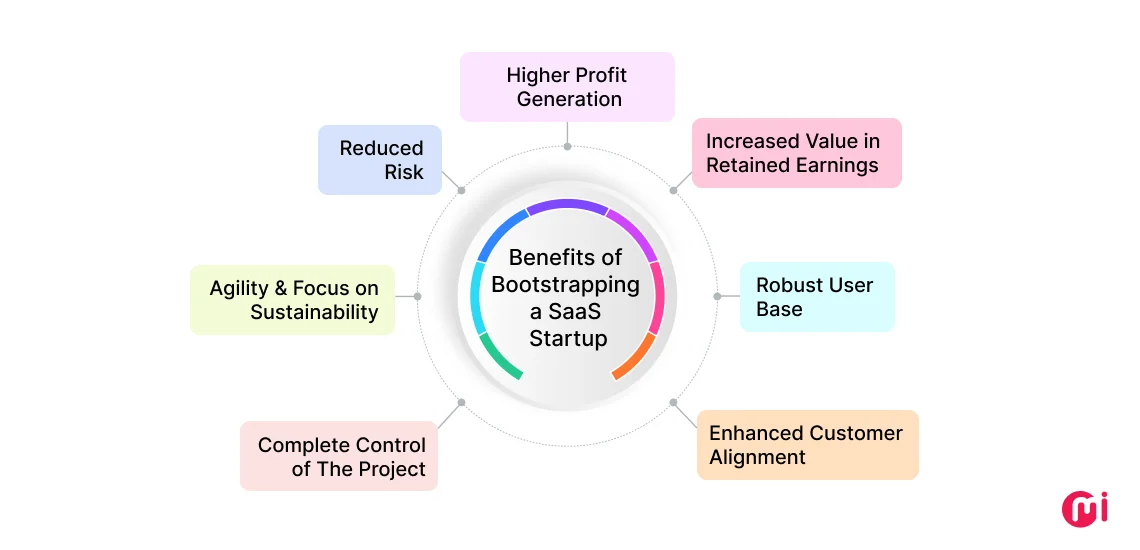How to Bootstrap a SaaS Startup in 2025?
- Business
- December 13, 2024
Bootstrapping a SaaS business involves developing it from scratch with your own savings, initial business profits, and/or funds from your friends and family. This blog discusses the 12 steps to bootstrap your SaaS startup along with the benefits and real-life examples of bootstrapped SaaS startups, easing your SaaS startup journey. Let’s explore!
It’s just 1%. Yes, you’ve heard that right! It’s only 1% of startups who succeed in getting funds from VC capital. As the majority of SaaS startups rely on VC capital, you should reconsider your approach and change it by bootstrapping your SaaS startup to grow on your own terms. Yes, it’s an excellent idea that most brands like Salesforce, Slack, Dropbox, and Hubspot employ.
Bootstrapping a SaaS is an excellent way to succeed in your SaaS startup idea without relying on outside investors. It not only keeps you independent from outside investors like VC capital and banks but also secures you from risks and debts. Consequently, you can make decisions independently in favor of your business with no intervention.

However, it benefits you a lot, bootstrapping a SaaS startup needs a predetermined approach consisting of multiple steps. Let’s learn all the steps to bootstrap your SaaS startup, along with its benefits and real-life examples. You can connect with a SaaS development company for expert consultation when you need them.
What Does Bootstrapping Mean In SaaS Startup?
Bootstrapping a SaaS involves the process of developing a Software-as-a-Service (SaaS) business from scratch without relying on external funding and resources such as loans, venture capital, and so on. To initiate a SaaS business, the owner may opt for either of the ways: using savings, initial profits earned from the business, or funds from friends and family.
Bootstrapping a SaaS aims to embrace growth and self-sustainability at a reduced amount of risks involved.
12 Steps to Bootstrap a SaaS Startup In 2025
After a sneak peek at the basics, it is time to come to the key discussion point and learn how to bootstrap your SaaS project. So, if you’re planning for something similar in the year to come, explore the following top 12 steps to bootstrap a SaaS company in 2025:
1. Validate Your Idea
What seems to be an excellent idea for you might not be a market fit for that very time. Hence, it is crucial to validate your business idea before you move any further. It might be tough for you to doubt your dream business idea; however, it is the right decision to pause and pre-sell your SaaS business idea to know the feasibility of its demands in the marketplace. When you validate the SaaS product idea before execution, it’ll bring you advantages in multiple ways, such as:
- Assurance of SaaS idea before development.
- Crucial data to anticipate your product’s success.
- Opportunity to collaborate with potential firms and clients.
Ways to pre-sell your SaaS startup idea:
- Conduct thorough market research by conducting surveys and interviews to understand the specific issues of users your software will resolve.
- Study your competitors and try to know if they have succeeded using a similar idea and project as yours.
- Interact with your potential customers and understand their obstacles along with the solution they are expecting from a new service provider. Get the feedback and implement it into your project to be able to resolve the issues of your target customers.
- Consider pre-selling your product for a limited time and among limited potential users.
- Gather the feedback from the customers who have already subscribed to your product during pre-sales.
2. Find Co-Founders and Mentors
Consider finding co-founders, CTOs, mentors, or advisory board members, as it is essential to get the right people who can be continuously dedicated to the project as your helping hand. These may include operation co-founders, financial co-founders, product/technology mentors, and business growth mentors.
Although they don’t work on a day-to-day basis with business, these mentors provide invaluable advice, guidance, and industry insights to support startups in navigating through challenges easily and growing exponentially. When you have these people working with you, you can grab an excellent chance to turn your SaaS project into a beneficial entity with no need for investors.
3. Choose an Effective Development Methodology
When you have chosen to bootstrap a SaaS product, you lack the luxury of ample time, resources, and money. Besides, you also need to find an efficient way to bring your product to life and market it as soon as possible. Therefore, opt for the right software development methodology, such as Rapid, Spiral, and Agile, that will work best for your project.
You can also use a combination of software development methodologies depending on your project requirements to embrace an outstanding outcome.
4. Choose the Right Technology Stack
To ensure full-fledged SaaS product development with optimized performance, security, and scalability, you need to choose the right tech stack wisely.
Employ technologies like React, Angular, and Vue.js for front-end development services. Big brands such as Alibaba and Xiaomi use Vue.js for their front end because of its enhanced flexibility.
Opt for Node.js, Django, or Ruby on Rails for backend development services. Popular brands including Pinterest and Instagram utilize Django, as it offers many features for security and scalability. Other apps like Netflix and LinkedIn employ Node.js for real-time data processing and efficient handling of applications with higher traffic.
5. Create a Minimum Viable Product of Your SaaS Product
MVP is an initial version of a product with limited features to be used by early adopters who can provide feedback for future software product development. It helps you get to know whether or not the product you’re going to develop aligns with your target audience. When creating MVP, make sure you add all the features that can address the issues confronted by your target clients.
Use the one-feature product or concierge model approach to create an MVP of your SaaS product.
Here is how creating an MVP brings success to bootstrapping a SaaS startup:
- Validating your SaaS startup idea before investment.
- Users have a glance at the core value of your product.
- You can simply alter the product’s idea and strategy without spending much time and resources.
- Streamlined time to market the product.
6. Create a Landing Page
Develop a simple and appealing landing page, allowing your target audiences to check all the details about your product and services. Having a landing page also helps you to receive your audience’s emails, letting you know your visitors are taking an interest in your product. What’s more, you can consider adding a video, showcasing and explaining all the crucial details, features, or works about your SaaS product.
It will enhance users’ awareness of your product and service offerings.
7. Consider Smart Recruitment
Hiring smart talents can have a huge influence on bootstrapping your SaaS startup. Define the role of development processes, determine the number of developers along with the required expertise and years of experience, and go with the hiring procedure accordingly. You should hire software developers with excellent knowledge of Java, PHP, and Python.
It would also be good to know Linux servers specifically for developing, managing, and maintaining them. A considerable understanding of cloud services platforms is also a pro to look for in a SaaS app developer.
You can use platforms like Toptal, GitHub, and LinkedIn to hire appropriate talents, or can simply get in touch with a reliable software development company to hire expert talents for your needs.
8. Use Free Tools & Resources to Reduce Cost
To cut down on the cost of a SaaS startup, it would be better to employ tools and resources available for no cost. You can leverage the following freely available tools to ease the task of SaaS bootstrapping at reduced expense:
- AWS free tier: To develop and test applications on the platform.
- Google Cloud free tier: To get started with Google Cloud and develop applications at no charge.
- Heroku (free tier): To develop, run, and operate apps completely in the cloud.
- Visual Studio Code (VS Code): To build and debug modern web and cloud-based applications.
You can employ these tools to perform a variety of tasks, such as work automation, intending to streamline procedures, boost productivity, enhance operational efficiency, and reduce the overall cost of the project.
9. Develop & Deploy Your SaaS Product
Develop the SaaS software, ensuring it comes embedded with all the necessary features and functionalities to cater to the specific needs of users. When done with the development, move towards QA testing, which might involve testing your SaaS product or service for performance, accessibility, usability, scalability, and security.
Once the software product passes through A/B, beta, and other testing, it is ready for deployment. Now go with the product launch and get started with your SaaS startup. Perform continuous monitoring to ensure the product delivers the solutions as it was destined to.

10. Conduct Marketing and Promotion
As a SaaS startup, you need to market and promote your products and services to bring them to the user’s awareness. Reach out to your potential customers via social media, emails, influencers, and other mediums. Consider defining a well-structured customer feedback collection and assessing the product.
Conduct surveys and one-on-one interviews after a certain period to gather real-time data about what your users are thinking about the product and improve accordingly.
11. Focus More on Revenue Generation & Frequent Cash Flow
When you are a bootstrapped SaaS startup, prioritizing sustainable growth is essential. Hence, prioritize revenue generation and a consistent cash flow. Create strategies to monetize, and open up more doors through which your startup can generate revenue and ensure a frequent cash flow. You can opt for a subscription-based pricing model with tiered plans, optimizing customer acquisition through digital marketing and sales, encouraging annual payments, and more for revenue generation and consistent cash flow.
12. Strategize to Scale the Product
Even if your newly developed SaaS product starts growing, create strategies to scale it as per the ever-growing user’s needs. You can utilize the following strategies to scale your SaaS product:
- Use Multichannel Approach
- Create Buyer Personas
- Provide Freemium Product
- Consider Using Analytics
- Optimize Pricing Strategy
- Deploy Referral Marketing
- Prioritize Customer Success
Ensure your strategy is focused on sustainable growth powered by customer referrals and feedback. You can also partner with businesses intending to expand your market reach and get exposure to your SaaS product. Once you achieve traction, your startup will start getting profits.
Benefits of Bootstrapping a SaaS Startup
Numerous benefits of bootstrapping a startup include complete control of the product, reduced risk, higher profit generation, and many more. Find a few of the SaaS startup bootstrapping benefits in the pointers below

Complete Control of The Project
Bootstrapping a SaaS startup means there is no involvement of investors or external stakeholders, allowing you a sense of control and ownership of your project and overall business.
Agility & Focus on Sustainability
Free from obligations to investors, SaaS startups tend to be increasingly agile to meet ever-evolving customers and market demands.
Reduced Risk
Bootstrapping a SaaS involves business growth on your own savings and initially earned capital from the same business. As there is no involvement of outside parties and investors, a startup owner faces reduced risk compared to those supported by external investors.
Higher Profit Generation
As we have already mentioned above, the SaaS startup has no intervention from external investors demanding a share of the business; the business profits remain in the complete control of the founder. It leads to higher growth and profits over time as the business scales.
Increased Value in Retained Earnings
Bootstrapped SaaS startups reinvest their earnings in the business that fuels sustainable growth, eliminating dependency on external capital.
Robust User Base
A bootstrapped SaaS startup focuses more on developing a product that meets end users’ needs rather than pleasing investors. It leads to a robust customer base, retention, and a lasting relationship with them.
Enhanced Customer Alignment
SaaS products are developed after a detailed analysis of users, the marketplace, and the overall scope to success; hence, they are more likely to remain in alignment with the user’s expectations.
Secret to Success of Top SaaS Products
There are different SaaS products out there with various aims and objectives. All of them have some traits that lead them toward success. Following are a few of the top SaaS brands and their key traits responsible for success:
| No. | SaaS Product | Top Reason for Success |
| 1. | Salesforce | Affordable pricing model |
| 2. | Slack | Simplified and appealing UI with intuitive functionality. |
| 3. | HubSpot | Product trial, content marketing, and relentless focus on customers. |
| 4. | Dropbox | Ultra-fast, ultra-simple syncing for large files, making information accessible from anywhere. |
| 5. | Intercom | Instant, accurate, and personalized customer communication via automated messaging and live chats. |
Real-Life Examples of Successfully Bootstrapped SaaS Startups
The following are some real-life examples of successful bootstrapped SaaS startups!
1. Mailchimp
Founded in 2001 by Dan Kurzius and Ben Chestnut, Mailchimp is an email marketing automation platform that allows users to create, send, and assess email marketing campaigns. Started as a side project, Mailchimp grew into one of the world’s largest email marketing platforms by offering a convenient and scalable solution for small organizations.
The platform focused more on user needs, offered them excellent services, and continuously expanded into other marketing tools such as social media advertising, SMS marketing, customer relationship management (CRM), eCommerce integration, A/B testing, and many more, as its user base scaled over time.
In the year 2020, Mailchimp’s revenue was $800 million and crossed $1 billion next year in 2021. Currently, Mailchimp’s estimated revenue is $344.7M per year.
2. Basecamp
Basecamp is a collaboration and project management software that was founded dated back to 1999 by Carlos Segura, Jason Fried, and Ernest Kim. This software assists organizations in planning and managing projects, collaborating with teams, and continuously tracking progress.
Basecamp’s success is immensely attributed to its user-friendly interface that focuses on simplicity and a straightforward approach to project management. The platform grew and became popular via organic word-of-mouth as well as paid advertising.
Basecamp has been continuously profitable for several years, generating millions in revenue year after year. Basecamp’s revenue per year was $43.7M in 2012, $185.6M in 2018, and $215.6M in 2020, which reached over $280M in 2024.
3. GitHub
Founded by Scott Chacon, Tom Preston-Werner, and Chris Wanstrath in 2008, GitHub is a platform aimed at software developers to host and collaborate on software development projects employing Git version control.
GitHub’s success was because of its ability to provide a simple yet scalable solution with features such as collaboration, version control, forking, and so on. It was bootstrapped for years; however, GitHub later received venture funding when it established an immense user base and started generating considerable revenue from paid plans.
Around 100 million software developers use GitHub, contributing to its annual revenue of $2 billion as of July 2024.

Bootstrap Your Way to SaaS Success with MindInventory!
As a client-oriented SaaS development company, MindInventory helps businesses across the globe with comprehensive solutions to bring their startup business idea to life. We help businesses with SaaS software design, development, cloud migration, and integration, as well as consulting solutions, ensuring complete assistance as per the requirements.
Employing our expertise and experience, we have developed innovative solutions like Passio.AI, and Caulibox for startups that deliver high-end performance and optimized ROI. Our products enabled the client to get the result, expanding their expectations. Here’s how we did it.
Passio.AI is a cutting-edge AI-powered solution that enables businesses to incorporate vertical-specific computer vision functionalities in their applications, fostering AI-powered user experience and sales. When it comes to the outcome, Passio.AI brings 97% accuracy for Nutrition AI, and 95% accuracy for Paint.AI while mitigating the dietary mistakes by 27%.
Caulibox, on the other hand, is London’s first brand with a reusable lunchbox scheme. The product helped our client save 9.75L of water consumption per use, reduce 237.5g of carbon dioxide emissions per use, and decrease 2.35MJ of energy consumed per use.
If you, too, have a SaaS startup idea that you want to turn into reality, we can be the right partner for you. With a team of 250+ professionals with an average of 6 years of experience, we have an excellent 90% client retention rate, advocating the quality we deliver. Share your idea of bootstrapping a SaaS startup, and let us help you turn it into reality!
FAQs on SaaS Startup
A few of the challenges that may come in the way of bootstrapping your SaaS startup are limited resources, balancing growth and finance, navigating cash flow constraints, and maintaining quality and innovation.
“Developing” a SaaS product involves only the technical process of developing the software, while “bootstrapping” conveys a broader approach that consists of developing, funding, growing, and scaling a startup business without relying on investors from outsiders.













